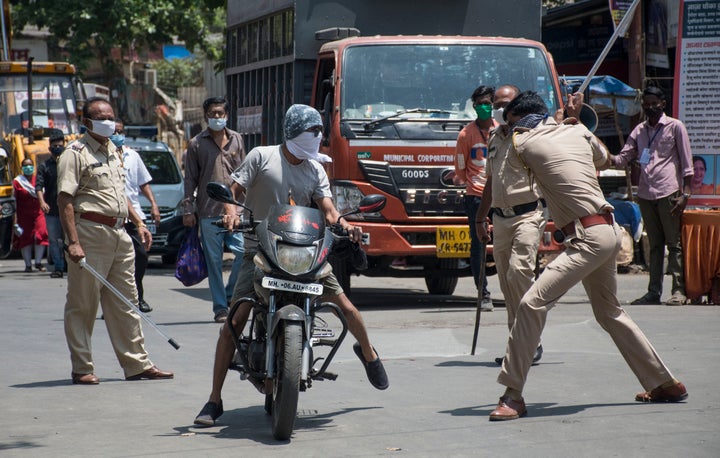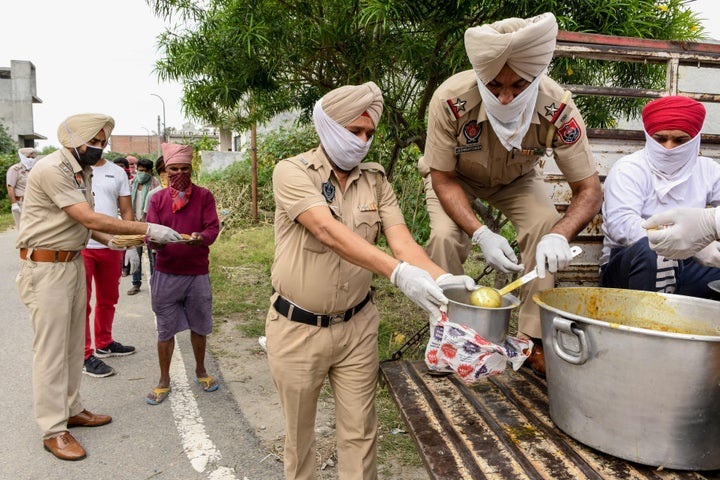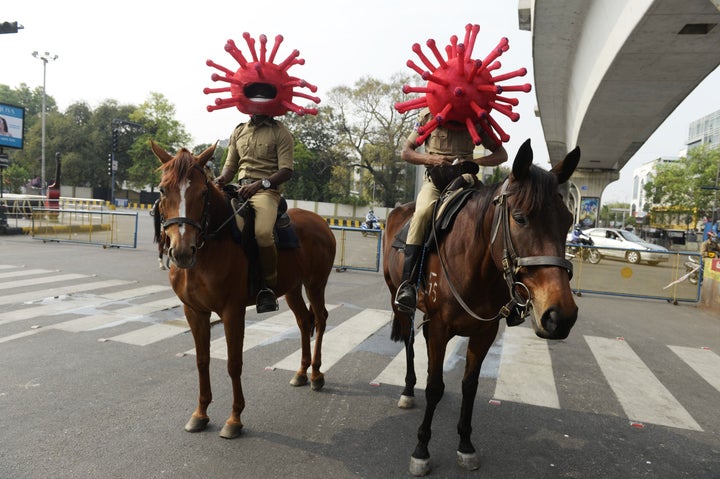
Since the Narendra Modi government announced a 21-day lockdown to halt the spread of Covid-19 in the country, the role of police officials asked to enforce the restrictions has come under the scanner.
While there has been severe criticism over instances of high-handedness during the lockdown, officials have also been praised for helping the elderly and vulnerable sections and using unique ways to spread awareness.
In the initial days of the lockdown, several e-commerce websites accused police officials of beating up delivery agents and harassing people who were out to buy essentials. Delivery app MilkBasket had alleged that its delivery staff was beaten up and it was forced to dump 15,000 litres of milk and 10,000 kg of vegetables. Grofers faced the same trouble while delivering essential goods.
Videos of police officials tipping over vegetable carts or making people who stepped out do squats and sit-ups went viral in the days immediately after the lockdown was announced.
Almost at the same time, reports emerged of police officials distributing food to daily wage workers, delivering masks and hand sanitisers to the elderly and medicines to people.
Police in some states also adopted unique methods to spread awareness, including wearing helmets inspired by the structure of the virus.
Devika Prasad, Programme Head of Police Reforms, Commonwealth Human Rights Initiative, told HuffPost India in an email interview that these deeply contrasting responses by the police “signalled the complete lack of preparedness, and failure by police leadership to orient the police in how to approach its role of enforcing the lockdown.”
The Ministry of Home Affairs, she said, could have issued an advisory to all police organisations as soon as the lockdown was announced, calling for zero tolerance of high-handedness, excessive or disproportionate force, while prescribing that only the minimal force necessary is to be used.
HuffPost India spoke to Prasad to understand what the government could have done to prevent the incidents of cruelty, how complaints not related to coronavirus can be handled and the effective ways police can use to enforce lockdown.
1. Since the lockdown began, there have been contrasting news reports on many days—while some policemen have been distributing food and helping the vulnerable, others have been caught on camera harassing migrant workers and poor people. What does this say about India’s police force?
This deeply contrasting response by the police, in shades humanitarian and in shades brutal and arbitrary, across the country, signalled the complete lack of preparedness and failure by police leadership to orient the police in how to approach its role of enforcing the lockdown. In the absence of the needed preparation and planning for a nationwide lockdown, the singular focus, overnight, became enforcement, and from what we witnessed in videos and images of police brutality, enforcement, by most police, was understood as wielding the lathi. In the absence of orientation-building for field-level police, in the absence of listing do’s and don’ts, in the absence of operational protocols on lockdown management, in the absence of clear instructions from police leaders that force was not to be resorted to, brute enforcement was inevitable.
It is heartening to read about and see police officials helping people and doing things much beyond their official duty, but in my view, this should have been the natural response, even with unpreparedness and in recognition of the immense challenges before all police personnel in this time. After all, this is a lockdown necessitated by a public health crisis. It is a measure to save lives and keep people safe, not punish them.
It is telling of how ingrained the resort to disproportionate violent force as the method of “enforcement” is in policing in India, and this is deeply damaging for policing overall, lockdown or not. There has been no vociferous condemnation by police leaders of the excessive force, and very little accountability. This policing cannot win efficiency, democratic consent or public trust.
2. What should the centre have done to sensitize the police right after the lockdown was announced to prevent cases of high-handedness and excesses?
While it is the primary responsibility of state police leadership to set the tone, orient and sensitise police, the Centre, specifically the Ministry of Home Affairs, could have issued an advisory to all police organisations as soon as the lockdown was announced calling for zero tolerance of high-handedness, excessive or disproportionate force in enforcement of the lockdown while prescribing that only the minimal force necessary is to be used. It could have urged every Director General of Police to immediately issue a Circular or Standing Order to this effect. States are not bound by MHA advisories as policing is a state subject, but I believe this would have sent a clear signal to all police organisations that it is essential to strictly adhere to norms on use of force, and make it clear that a lockdown is no cover or justification for high-handed, excess or disproportionate force by law enforcement agencies. It would have presented a good opportunity to reinforce and affirm the standards in the UN Basic Principles on the Use of Force and Firearms by Law Enforcement Officials, signed by the Government of India, to all states.

3. How do you think the police force can deal with overworked personnel? Police personnel are not only enforcing the lockdown, but also helping deliver essential items to people sometimes and coordinating the distribution of cooked food.
This is a major challenge for police organisations, and especially police leaders, in getting through this period of lockdown which, by all indications, will continue in some form for a longer period than anticipated. It’s not just about overworked personnel, in the face of the Covid-19 pandemic, police personnel are at great risk of both contracting and spreading the virus as the very nature of policing requires them to come into contact with countless number of people. Police leadership may have to anticipate and plan for various levels of illness among the police as long as infection levels are high; and this is when most police are already operating in shortfall, not full strength. It is crucial for leadership to lay out clear contingency plans, with immediate effect, for managing drops in manpower, ensuring uninterrupted policing services and access to police, and also to guarantee full support, including cost of treatment, guaranteed pay and leave to recover, to all personnel and their families during the course of the pandemic. Police leaders and supervisors need to be in constant dialogue with the rank and file and assure everyone down the ranks that they are with them in this time.
4. While the police is busy managing all the aspects of a lockdown, how can other complaints be handled? NCW said there has been a rise in the number of domestic violence complaints.
This is another major challenge before the police to ensure that core policing functions and access to police is not hindered during the lockdown. During a lockdown, governments and police must recognise the heightened threats to victims of sexual abuse, matrimonial and domestic violence, which we are seeing through the rise in complaints of violence and abuse. Not being able to move out of homes means victims cannot access safe spaces or any respite. Recognising this, governments must set up telephone helplines (with wide publicity) and safe short-stay homes for victims wanting to escape. In some European countries, for instance, hotel rooms have been made available for women to move into. Police will have to step in to facilitate safe escape, transport, and protection to victims.
It is for governments and police to think about the needs to be met and how best to meet them through all the resources and partnerships available, as this is not work for one agency alone, just as in non-lockdown times. Governments should work with and resource the nongovernmental organisations that provide assistance to domestic violence victims, including shelter, counselling and legal aid. The police would be greatly helped in its role if it worked in partnership with these organisations who have the trust of survivors. Protection officers appointed under the Prevention of Domestic Violence Act, and legal aid lawyers have an immense role to play to respond to and protect victims, both on their own and in collaboration with the police. The experience of the lockdown provides an opportunity for an overburdened police to leverage partnerships with existing resources towards a better response to these most vulnerable of victims.
Taking into account the major pressures and dual responsibilities on the police to both enforce the lockdown and attend to core police functions, police leaders will be devising ways to manage the use of existing manpower. To minimise disruption of core policing functions and access to police, it would be important to find ways to not divert police personnel posted in police stations or special units from their duties, as difficult as this may be in this time.
(Ed—France said it would pay for hotel rooms for victims of domestic violence)
5. State/city police have resorted to different methods to enforce the lockdown — Chennai police made people do half-squats, Bengaluru police has started confiscating vehicles, police in Telangana made violators stand with placards carrying messages on social distancing. What is the most effective way that police officials can adopt to ensure people stay at home?
This requires a layered response. Firstly, I condemn the resort to punitive and humiliating measures by police as methods of enforcement. In my view, the aim and thrust of the police response should be to encourage voluntary, and certainly, non-coerced compliance. This needs to come with the understanding of certain realities — that people will have to be out on the streets and public spaces to access everyday essential supplies, medicines, ration and provisions for their households; not everyone can work from home; vulnerable groups have particular needs; and emergency or medical assistance may have to be sought. There is a need for all authorities in an enforcing role, especially the police, to recognise that there are legitimate and necessary reasons for people to be out during the lockdown. It is up to police leadership to set the tone that there cannot be a punitive approach.
Field-level police would have to be oriented and equipped to dialogue, engage with and understand why people may be out on the streets and then have a ready roster of appropriate responses, whether it is providing a referral, helping someone to reach a destination or hospital, or simply facilitating their movement. This in itself requires the police to devise a specific protocol — for instance a “Stop, Verify and Assist” Protocol that lays down the justified reasons a person or persons may be out on the streets, and gives field officers specific pointers on how to respond. Of course, as this is real life dynamic situations, police officers will also have to rely on their individual judgement at times, and it is hoped sensitivity prevails.
In terms of trying to keep people at home, punitive measures should not be resorted to at all, or only as a last resort if it is a situation in which life or property is endangered. Where police find people out on the streets without a reasonable need or justification, novel responses can be devised such as giving a warning or mandatory community service.
If punitive measures become necessary, police must be advised that these are in adherence with legal provisions and proportionate to the situation at hand.
Meting out publicly humiliating “punishments” or resorting to beatings must be prohibited, codified as serious police misconduct, and strict action should be taken against police perpetrating these.
CHRI has also put together a set of guidelines for the police towards a rights based approach.
6. Sola, Sangli, Guwahati Police are reportedly using drones to keep an eye on people’s movement. Is that an effective way to enforce lockdown and what are the privacy concerns with the use of drones?
Experts have warned that public health crises can lead to heightened surveillance which can grow into a surveillance state. Privacy is a fundamental right of every citizen of India and all state agencies have to uphold it, including the police. It is about striking the most necessary balance between taking the measures to defeat this crisis while ensuring the fundamental right to privacy is not violated.
In terms of the lockdown and also the need to maintain physical distancing, I can see the utility of using drones, at a distance, to alert the police in real-time if, for instance, crowding is happening in an area. Or to give visuals, again from a distance, of areas, localities, streets which are dimly lit or difficult to access. But there must be a discipline in the use of drones and the guarantee that they are never used as devices to track or monitor the movement of individuals, which would be an express breach of the right to privacy.

7. There have been rising cases of racism against the people from the Northeast. How, do you think the police can prevent them and deal with perpetrators?
Acting against and preventing racist attacks requires a gamut of actions and measures, with the primary obligation on governments to act first. Governments must launch public campaigns in engaging ways through simple language and visuals where possible, to make clear that Covid-19 is not to be identified with any community and it would be an act of discrimination to do so. Prevention campaigns need to reach neighbourhoods through roping in Resident Welfare Associations or other relevant community collectives where RWAs are not present.
The police too, through social media or videos, should put out similar messaging. Special units or helplines set up by police departments to respond to people from the North East need to be visible and active. Special units can take the lead to formulate responsible and needed messaging. Police can collaborate with civil society organisations, community leaders, and human rights defenders to spread these messages through different platforms. Special helpline numbers should be widely publicised. Constant monitoring and measures need to be taken to ensure the helplines are not dormant, non-responsive or slow. Police must respond and reach when called.
With the need to limit taking people into custody during the time of the Covid-19 pandemic, against the need also to respond to discriminatory acts, the police will have to be flexible and mindful in its approach. Situations can be addressed without punitive force or action and this needs to be maximised as far as possible. For instance, if a person from the North East is prevented from going into a grocery store, a police officer no lower than the rank of Sub-Inspector should reach the spot at the earliest, admonish the shopkeeper or person who prevented access, let the persons into the shop, stand guard for the duration that the affected person(s) complete their shopping, and help them back to their residence. Resolute but non-punitive actions like this can also have lasting deterrent effects
8. Some city police officers have recently been seen wearing ‘corona helmets’ and doing skits to raise awareness. How effective are such strategies?
It is good to implement interactive, community-level strategies like these to raise public awareness. Though in terms of priorities, it is my view that it is the government’s job primarily to be active and responsible in putting out relevant information to the public on what is being done to fight against the virus, and also to raise public awareness of precautionary measures to take. The police have a lot on their plate already.